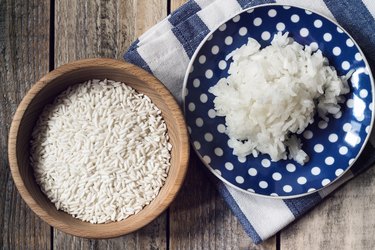
Glutinous rice, or sticky rice, is a refined short- or long-grained white rice that is a staple food in many cultures, including Laos and Thailand. It is called glutinous or sticky rice because of its glue-like texture, and it can be eaten out of hand or alongside soups and stews. This grain provides calories and carbohydrates, offering minimal protein or fiber.
Flavor and Texture
Video of the Day
Glutinous rice has a flavor similar to many other refined, white rices. The texture of cooked sticky rice sets it apart. Sticky rice contains only one type of starch, amylopectin. When amylopectin is exposed to hot water or steam, the structure of the grain changes. If glutinous rice is steamed, it becomes chewy and sticky. Boiled sticky rice develops a soft, mushy texture. Unlike most types of rice, sticky rice becomes rather transparent when cooked.
Video of the Day
Calories and Carbs
According to the United States Department of Agriculture, a 1 cup serving of sticky rice contains 169 calories, or about 8 percent of your calories on a 2,000 calorie diet, and almost 37 grams of carbohydrates. Between 45 percent and 65 percent of your daily calories should come from carbohydrates. Nearly all of the calories in sticky rice are from carbohydrates.
Protein, Fiber, Other Nutrients
Each 1 cup serving of sticky rice provides 3.5 grams of protein and 1.7 grams of fiber. If you consume 2,000 calories a day, you need 28 grams of fiber each day, so 1 cup of sticky rice provides around 6 percent of the fiber you need each day. Adults require 46 to 56 grams of protein daily, with 1 cup of glutinous rice meeting just 6 percent or less of your daily requirement. Sticky rice has negligible amounts of other nutrients and is not a good source of fiber, vitamins or minerals.
Refined Grain
Glutinous rice can help you reach the recommended 6 oz. to 8 oz. of grains per day. A 1 cup serving of sticky rice provides almost 2.7 oz. of that requirement. At least half the grains you eat each day, however, should be whole grains, rather than refined grains like sticky rice. Glutinous rice does not contain gluten, a protein found in wheat, and is safe for people on a gluten-free diet. If you wish to include more whole grains in your diet, replace sticky rice with short-grain brown rice.
Sticky Rice Meals
Glutinous rice can be quite unhealthy if you pair it with rich sauces or fried foods. Serve sticky rice alongside flavorful stir fries loaded with vegetables or pair it with heart-healthy fish. Adding fruits and vegetables to a meal containing sticky rice provides the vitamins and minerals you need. Including fish, tofu or another healthy protein source can round out a well-balanced meal.
- USDA; Nutrient Data Laboratory; Search
- Thai Food and Travel; White Sticky Rice – Kao Niow; Kasma Loha-Unchit
- "Smithsonian"; A Taste of Sticky Rice, Laos' National Dish; Mike Ives; February 2011
- Department of Health and Human Services: Choose Carbohydrates Wisely
- Centers for Disease Control: Carbohydrates